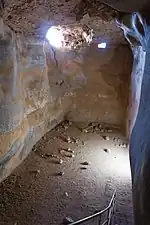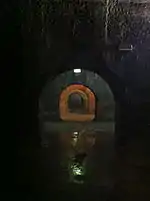
The list of Roman cisterns offers an overview over Ancient Roman cisterns. Freshwater reservoirs were commonly set up at the termini of aqueducts and their branch lines, supplying urban households, agricultural estates, imperial palaces, thermae or naval bases of the Roman navy.[1]
Cisterns
| Cistern | Location | Country | Water supply | Width (m) |
Length (m) |
Clear height (m) |
Water depth (m) |
Capacity (m³) |
Volume (m³) | |
|---|---|---|---|---|---|---|---|---|---|---|
 |
Basilica Cistern or Yerebatan Saray | Constantinople | Turkey | Rainwater harvesting | 65 | 138 | 9 | 85,000 [2] | ||
| Bordj el-Djedid | Zaghouan | Tunisia | Aqueduct of Carthage | 39 | 154.6 (oblong) | 25,000 to 30,000 [2] | ||||
 |
Cistern of Philoxenos or Binbirdirek Cistern | Constantinople | Turkey | Rainwater harvesting | 66 | 65 | 14 to 15 | 32,500 [2] | ||
 |
Theodosius Cistern | Constantinople | Turkey | Rainwater harvesting | ||||||
 |
Cistern System at Masada
(Northern Cisterns) |
Judaean Desert | Israel | Rainwater harvesting | 40,000[3] | 40,000[3] | ||||
 |
Piscina Mirabilis | Bacoli near Misenum | Italy | Serino Aqueduct | 25 [4]
(27 [2]) |
66 [4]
(72 [2]) |
10.3 [4]
(±10 [2]) |
7.5 [4]
(? [2]) |
10,700 [4]
(12,600 [2]) |
14,300 [4]
(? [2]) |
 |
Roman cisterns | Fermo | Italy | Rainwater harvesting | 30 | 70 | 6 | 0,70 | 3,000 | 10,000 [4] |
| Grotta Dragonara | Bacoli near Misenum | Italy | Rainwater harvesting | 70 [4]
(6 [5]) |
72 [4]
(60 [5]) |
9.5 [4]
(? [5]) |
4.5 [4]
(? [5]) |
7,700 [4]
(? [5]) |
11,900 [4]
(? [5]) | |
| Il Cisternone | Albano | Italy | 10,132 [6] | |||||||
| Cisternone Romano | Formia | Italy | 25 | 65 | 6.5 | 8,000 [2] | ||||
 |
Aïn Mizeb | Thugga | Tunisia | Aqueduct | 9,000 | |||||
 |
Aïn El Hammam | Thugga | Tunisia | Aqueduct | 6,000 | |||||
| Cripta Romana | Cumae | Italy | Serino Aqueduct | 31 | 38 | 8.0 | 3.0 | 2,100 | 5,300 [4] | |
| Piscina Cardito, Southern Reservoir |
Puteoli | Italy | Campanian Aqueduct[7] | 16 | 55 | 6.0 | 4.5[B 1] | 4,000[B 1] | 5,300 [4] | |
| Piscina Lusciano | Puteoli | Italy | Serino Aqueduct | 25 | 27 | 6.5 | 4.0[B 1] | 2,700[B 1] | 4,400 [4] | |
| Tunnel Cistern[A 1] | Baiae | Italy | Rainwater harvesting | 3.5 | 300 | 3.0 | 2.0 | 2,100 | 2,800 [4][B 1] | |
| Cento Camerelle, Upper Reservoir |
Misenum | Italy | Rainwater harvesting | 18 | 23 | 7.8 | 5.5 | 2,000 | 2,450 [4] | |
| Cento Camerelle | Puteoli | Italy | Campanian Aqueduct? | 7 | 70 | 5.2 | 2.0 | 850 | 2,000 [4] | |
| Cento Camerelle, Lower Reservoir[A 1] |
Misenum | Italy | Rainwater harvesting | 2 | 160 | 4.0 | 3.0 | 960 | 1,100 [4][B 1] | |
| Piscina Cardito, Northern Reservoir |
Puteoli | Italy | Campanian Aqueduct[7] | 8 | 34 | ? | 1.3[B 1] | 350[B 1] | ? [4] | |
| Domitian's Villa [6] | Albano | Italy | 11 | 123 | ||||||
| Villa Jovis | Capri | Italy | ||||||||
Notes
See also
References
- ↑ Döring 2002, pp. 310–319
- 1 2 3 4 5 6 7 8 9 10 De Feo, Giovanni & De Gisi, Sabino & Malvano, Carmela & De Biase, O. (2010). The Greatest Water Reservoirs in the Ancient Roman World and the “Piscina Mirabilis” in Misenum. Water Science & Technology: Water Supply. vol. 10, issue 3, pp 350–358. Publication by IWA Publishing, 2010.
- 1 2 "Masada National Park". Israel Nature and Parks Authority. Retrieved 2023-03-28.
- 1 2 3 4 5 6 7 8 9 10 11 12 13 14 15 16 17 18 19 20 21 All data from: Döring 2002, pp. 310–319 (esp. 313)
- 1 2 3 4 5 6 Cucco, Mauro (10 January 2022). "Grotta della Dragonara". bacoli.it (in Italian). Retrieved 2023-03-27.
- 1 2 Adam 2004, pp. 250–51
- 1 2 Ferrari, Graziano. "The campanian aqueduct stairway rediscovered".
{{cite journal}}: Cite journal requires|journal=(help)
Sources
- Adam, Jean-Pierre (2004), Roman Building. Materials and Techniques, Routledge, ISBN 978-0-415-20866-6
- Döring, Mathias (2002), "Wasser für den 'Sinus Baianus': Römische Ingenieur- und Wasserbauten der Phlegraeischen Felder", Antike Welt, vol. 33, no. 3, pp. 305–319
Further reading
- De Feo, Giovanni & De Gisi, Sabino & Malvano, Carmela & De Biase, O. (2010). The Greatest Water Reservoirs in the Ancient Roman World and the “Piscina Mirabilis” in Misenum. Water Science & Technology: Water Supply. vol. 10, issue 3, pp 350–358. Publication by IWA Publishing, 2010.
External links
![]() Media related to Roman cisterns at Wikimedia Commons
Media related to Roman cisterns at Wikimedia Commons
- Roman Aqueducts – Basins in Roman aqueducts
- Traianus – Technical investigation of Roman public works
This article is issued from Wikipedia. The text is licensed under Creative Commons - Attribution - Sharealike. Additional terms may apply for the media files.